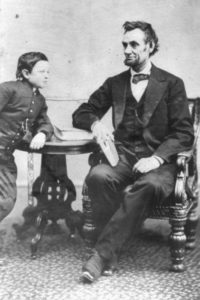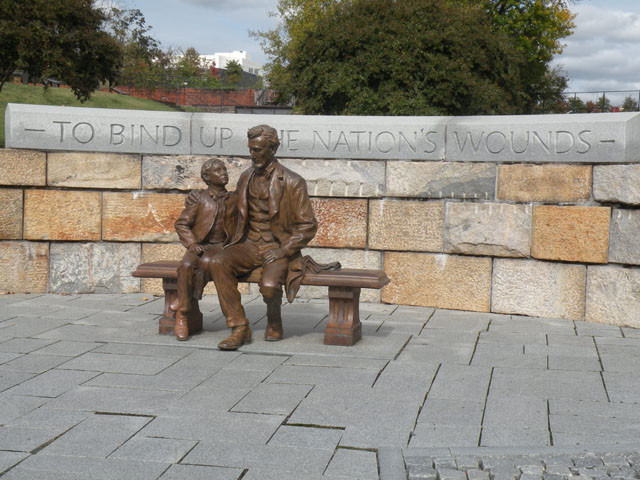Abraham Lincoln had a particular affinity for ironclads, and today would bring him closer to both the Union ironclad Monitor and the CSS ironclad Virginia (formerly the Merrimack). On May 5, 1862, Lincoln, Secretary of War Edwin Stanton, Secretary of the Treasury Salmon Chase, and other dignitaries set sail on the revenue cutter Miami. Their destination – destiny.
The day began with a visit from Lieutenant John Worden. Worden was recuperating after receiving wounds while commanding the Monitor against the Virginia at Hampton Roads in early March. The “battle of the ironclads” changed the Navy forever, as it became clear the old wooden sailing ships would not be able to withstand an onslaught from largely unassailable iron vessels. Worden had been in the pilot house of the Monitor when a shell from the Virginia struck, temporarily blinded as the two ships battled to a draw. Still with impaired eyesight (he would eventually recover), Worden stopped by to brief President Lincoln at the White House; tomorrow he would visit the Capitol.

That evening Lincoln would be headed for Fort Monroe on the Miami. With driving rain and stormy seas, even Lincoln, who had spent much time on the waters as a flatboatman and river pilot, felt ill and unable to eat, according to Chase, who suffered the same fate. During their trip they stopped off to tour the eponymously-named ocean steamer provided to the navy by wealthy magnate Cornelius Vanderbilt. After arriving at Fort Monroe they sailed out into Hampton Roads and toured the Monitor, now improved with a new steam pump and engines in preparation for their next encounter with the Virginia. According to the Monitor‘s paymaster, William Keeler, Lincoln “examined these vessels with much care, making the most detailed inquiries as to their construction and operation.” He would have seen the dented turret made by the Virginia‘s cannonballs, along with the rebuilt and modified pilothouse where Lt. Worden had been injured.
As the week progressed, Lincoln would get close enough to see the Virginia sitting off Craney Island. The stage was set for another Monitor/Virginia battle, a battle that would never take place, in part due to Lincoln’s actions. In his book Lincoln Takes Command, Steve Norder describes how Lincoln served as his own commanding general in Hampton Roads, directing and pushing for the taking of Norfolk and the Gosport Navy Yard in nearby Portsmouth. He even guided a landing party on Confederate-held soil in search of a spot for the Union Army to make their trek into the city as it was being abandoned by the Confederates.

Meanwhile, all this activity being directed by Lincoln created problems for the CSS Virginia. Unwilling to take on the Monitor and its supporting ships, the Virginia‘s commander began preparations to run the ship up into the James River. Unfortunately, removing ballast to reduce how low the ship sat in the water made the Virginia neither capable of moving into shallower water nor in a position to fight its way out to the sea. Facing an unfathomable situation, commander Josiah Tattnall opted to save his crew for the future and destroy the Virginia to keep it out of Union hands. Lincoln and others could see the burning hulk from the Monitor and Fort Monroe. The Confederacy’s first ironclad was no more.
As they made their way back to Washington on the USS Baltimore, Secretary Chase wrote his daughter:
“So ended a brilliant week’s campaign of the President,” Chase wrote. He was “quite certain that if he [Lincoln] had not come down, Norfolk would still have been in the possession of the enemy & the Merrimac as grim & defiant & as much a terror as ever.”
This was the only case of a sitting president taking active command of troops in the field during a time of war. By the time Lincoln had returned to the Washington Navy Yard on May 12th, news of the capture of Norfolk and the destruction of the Virginia had already reached the city. Lincoln was greeted as a conquering hero. The Monitor never did get its second encounter with the Virginia, and it too would find a watery grave not long after in a storm. But the age of wooden sailing ships was over. The age of iron ships had begun.
David J. Kent is an avid science traveler and the author of Lincoln: The Man Who Saved America, in Barnes and Noble stores now. His previous books include Tesla: The Wizard of Electricity and Edison: The Inventor of the Modern World and two specialty e-books: Nikola Tesla: Renewable Energy Ahead of Its Time and Abraham Lincoln and Nikola Tesla: Connected by Fate.
Check out my Goodreads author page. While you’re at it, “Like” my Facebook author page for more updates!



 On April 4, 1865, President Abraham Lincoln took his son Tad into the city of Richmond, Virginia. The city had fallen the day before into Union hands two days before. It was Tad’s 12th birthday.
On April 4, 1865, President Abraham Lincoln took his son Tad into the city of Richmond, Virginia. The city had fallen the day before into Union hands two days before. It was Tad’s 12th birthday.







